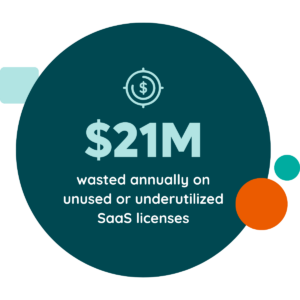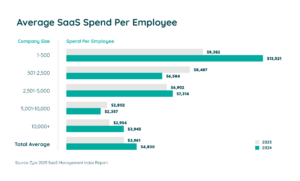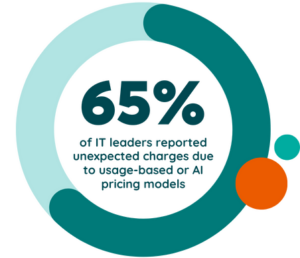05/20/2025
Table of Contents
CIOs, you’re not imagining the pressure. Cloud, AI, and SaaS are no longer separate challenges. They’re converging into a single, fast-moving force that demands a new approach. If your strategy hasn’t evolved, you’re already behind.
Boards want clarity on AI. Teams are adopting SaaS faster than IT can govern it. Cloud costs keep climbing. Finance expects discipline and innovation at the same time. The old IT playbook no longer fits.
You’re not alone. At Zylo’s SaaSMe 2025 event, the executive panel session “Navigating the Convergence of Cloud, AI and SaaS” brought together leaders who are responding to these pressures in real time and changing how IT operates.
The panel featured Keith Sarbaugh (Chief Digital & Technology Officer, Zoetis), Siroui Mushegian (CIO, Barracuda), and Jez Back (Cloud Economist & Global Offer Leader, Capgemini). Each shared practical ways to lead through chaos and build control into complexity. As Zylo’s COO, D Wayne Poole, noted, “This tech convergence presents incredible opportunity and daunting complexity.”
Here’s how they’re adapting—and what every CIO needs to consider next.
1. Cloud, AI, and SaaS Are Colliding—And Complexity Is Rising
The pillars of enterprise IT—cloud infrastructure, SaaS delivery, and AI—are no longer discrete layers. They’re colliding in real time, resulting in complexity that CIOs can’t ignore. According to Keith Sarbaugh, Chief Digital & Technology Officer at Zoetis, relying on best-of-breed point solutions has become a liability. “Platform thinking,” he explained, “offers the visibility and predictability we need to manage spend and risk at scale.”
The data backs it up. The average organization now adds seven new SaaS apps monthly, with AI leading as the fastest-growing category by app count and spend. As AI continues to embed itself into SaaS and cloud ecosystems, CIOs must contend with a rapidly evolving stack—and little room for manual oversight. Without governance at the platform level, operational debt builds fast.
“This is not just a tooling issue—it’s a structural problem. Complexity is now constant.”
Tactical Steps
To stay ahead, CIOs must simplify and centralize where possible.
- Reduce portfolio sprawl. Organizations still manage an average of 275 SaaS apps, even after two years of rationalization efforts. Use a SaaS Management Platform like Zylo to audit your environment, flag redundant tools, and build a roadmap for consolidation.
- Align around platform vendors. Consolidating functions within a few extensible platforms minimizes integration gaps and strengthens compliance efforts. This shift also helps IT regain oversight as SaaS ownership drifts toward business units.
- Embed FinOps early. Zylo data shows that IT now owns just 26% of SaaS spend, with the rest managed by departments or individuals. Bringing FinOps into the intake process ensures spend visibility before it happens—not after.
2. FinOps Strategy Is Now Business-Critical
SaaS now rivals cloud infrastructure as one of IT’s largest and fastest-growing cost centers. What makes it more complex is the shift to decentralized ownership and usage-based pricing. Most SaaS spend happens outside IT’s control, making tracking and forecasting difficult—unless FinOps is fully embedded.
 Siroui Mushegian described how Barracuda evolved its FinOps function from a reactive cost monitor into a proactive business partner. Rather than retroactive cost analysis, FinOps now supports decision-making from the start. This is a shift that more organizations are beginning to embrace.
Siroui Mushegian described how Barracuda evolved its FinOps function from a reactive cost monitor into a proactive business partner. Rather than retroactive cost analysis, FinOps now supports decision-making from the start. This is a shift that more organizations are beginning to embrace.
Zylo data reinforces the need. On average, organizations waste $21M per year on unused licenses. Worse, companies are only using 47% of the SaaS licenses they pay for. Without FinOps driving optimization, these losses continue unnoticed.
“FinOps has to be embedded, not adjacent. It needs to partner with IT, finance, and procurement from day one.”
Tactical Steps
To elevate your FinOps maturity, tie it directly to strategic planning.
- Broaden the FinOps scope. Most FinOps teams started in the cloud. Now, SaaS requires equal focus. Apply forecasting, rightsizing, and unit cost modeling to applications, not just infrastructure.
- Build a cross-functional team. A modern FinOps model includes finance, IT, and procurement. This alignment ensures spending decisions reflect usage, performance, and business needs.
- Use benchmarks strategically. Zylo Benchmarks provide pricing and utilization comparisons across a wide range of applications. These insights turn renewals into data-backed negotiations.
3. AI in SaaS Is Fueling Urgency—and Forcing Governance
AI adoption isn’t a distant trend—it’s happening now, inside the apps your teams already use. Generative AI has become one of the fastest-growing SaaS categories in terms of both the number of apps and total spend. That rise is bringing urgency, risk, and new demands for oversight.
Both Keith Sarbaugh and Siroui Mushegian spoke to the influx of AI proposals across departments. Employees are experimenting with tools like ChatGPT, while business units pitch AI-driven solutions with little clarity around ownership, compliance, or ROI. Jez Back summed up the moment simply: it’s time to govern.
Barracuda’s response was to launch an AI Council to vet every new initiative. At the same time, Zoetis split its AI investments into two streams—one for strategic innovation and another for operational tools. This allowed them to move quickly without sacrificing accountability.
“Playtime is over. We can’t afford to let AI grow unchecked. Structure is what keeps speed from turning into risk.”
— Jez Back, Capgemini
Tactical Steps
CIOs must provide frameworks that encourage innovation but enforce clarity.
- Stand up an AI Council. Include stakeholders from legal, security, compliance, IT, and the business. This team can evaluate AI use cases, prioritize value, and ensure safeguards are in place before rollout.
- Define dual-track governance. Segment AI initiatives into strategic (e.g., product innovation) and operational (e.g., CoPilot). Each track can have distinct approval paths based on risk and complexity.
- Accelerate with structure. Use intake forms, pre-approved use case templates, and automated risk checklists to streamline requests without bypassing governance.
Evolving Your SaaS Governance Framework for the Digital Workplace
Learn More4. Budgeting for Innovation Requires New Financial Models
The days of static, predictable IT budgets are gone. With SaaS and AI introducing variable usage patterns and evolving capabilities, CIOs need models that support experimentation without compromising accountability. The average SaaS spend per employee is now $4,830—a 21.9% YoY increase.

Keith Sarbaugh described Zoetis’ internal venture model. The company allocates a portion of its digital budget specifically for AI and GenAI projects. These investments start with a rough business case and are reassessed based on downstream impact. At Barracuda, Siroui Mushegian adds flexibility through budget buffers and tracks measurable returns to justify continued investment.
Zylo’s research shows the pressure is widespread. In 2024, 88% of IT and SAM leaders report flat or minimal budget growth, yet 69% still cite driving innovation as a top priority. Forward-looking financial models are how CIOs reconcile those constraints.
“You have to fund the unknown. Otherwise, innovation gets crowded out by the urgent.”
— Keith Sarbaugh, Zoetis
Tactical Steps
To support innovation under constraint, blend agility with financial discipline.
- Establish an innovation fund. Dedicate 10–15% of your IT budget to exploratory initiatives. Keep governance lightweight, but require some alignment to business outcomes before funding.
- Measure downstream impact. Track changes in revenue, productivity, cycle times, or customer experience. Use this data to advocate for continued support or redirect funds if ROI falls short.
- Educate finance on strategic spend. Help stakeholders distinguish between growth-driving investment and inefficiency. Use benchmarking data to contextualize spend patterns.
Guide to Managing SaaS Costs
Learn More5. SaaS Surprises Are Real—Governance Is the Antidote
Surprise bills from SaaS vendors are no longer rare. They’re becoming a routine pain point for CIOs managing dynamic, decentralized software environments. Consumption-based pricing models, auto-renewals, and unused licenses can all lead to unplanned expenses.
Siroui Mushegian shared how Barracuda addressed this by standing up standardized intake processes and using Zylo to create a centralized view of their SaaS environment. With that visibility, her team caught billing spikes, duplicate purchases, and underused tools before they became budget issues.
Zylo data shows the risk is real. On average, organizations only use 47% of their purchased licenses, and 23 applications per company are paid for through multiple channels (e.g., both expense and accounts payable). Without centralized governance, waste and exposure multiply quickly.
“We couldn’t keep absorbing surprises. Governance gave us control, but more importantly, it gave us foresight.”
— Siroui Mushegian, Barracuda
Tactical Steps
Governance is how CIOs move from reactive cleanup to proactive control.
- Standardize SaaS intake. Route all app requests through a shared intake process. Include budget checks, security reviews, and FinOps evaluation to eliminate surprises before signing contracts.
- Monitor usage continuously. Platforms like Zylo provide real-time analytics across all applications. This visibility lets teams detect usage spikes, idle licenses, or shadow IT purchases early.
- Drive ownership with accountability. Assign business owners to each application. Hold them responsible for license usage, budget alignment, and reporting value back to IT and finance.
6. Collaboration Is the Only Way Forward
The days of centralized IT command and control are over. In a SaaS-powered enterprise, every department is a technology buyer. As Jez Back put it, “Everyone’s a buyer now.” This shift requires a cultural change for CIOs—one where governance is shared, not enforced.
Keith Sarbaugh illustrated this at Zoetis, where teams now operate with clear cost targets and dashboards that make SaaS spend transparent. These metrics aren’t buried in IT reports—they’re visible across the company. That visibility created shared accountability and sparked friendly competition to optimize software usage.
Zylo’s research shows why this model works. Only 26% of SaaS spend is owned by IT. Business units manage the majority, so collaboration isn’t optional—it’s essential.
“You can’t govern by mandate anymore. Influence, transparency, and shared goals are the path forward.”
— Jez Back, Capgemini
Tactical Steps
To create alignment, CIOs need shared structures and real-time visibility.
- Create a SaaS Council. Form a cross-functional working group with IT, finance, procurement, and business unit representatives. Meet regularly to align on goals, upcoming renewals, and optimization priorities.
- Make spend visible. Use dashboards to show each team its SaaS portfolio, utilization rates, and spend trends. This transparency prompts behavior change faster than policy enforcement alone.
- Gamify optimization. Assign savings targets or license utilization goals by department. Publicly track progress to motivate teams and make SaaS management feel like a shared win.
The No-BS SaaS Management Playbook
Learn MoreFinal Word: Control the Complexity, Fund the Future
The CIOs on this panel aren’t reacting to change—they’re building systems to harness it. Governance, FinOps, collaboration, and AI strategy are no longer separate initiatives. Together, they form a modern operating model for technology leadership.

The data is clear: 93% of IT and SAM leaders include SaaS in their cloud optimization efforts, yet nearly half still see minimal results. While 66.5% of IT leaders have experienced unexpected charges from AI or consumption-based pricing, many are still using outdated tools or static spreadsheets to track software.
That gap between intent and impact is where opportunity lives. Zylo’s SaaS Management Index shows that organizations waste an average of $21M annually on unused licenses. Most companies only use half the software they buy. Without centralized governance and real-time visibility, overspending, redundancy, and risk become the norm.
“SaaS is my second largest cash expense. And it’s growing the fastest. We had to get serious about it.”
— Keith Sarbaugh, Zoetis
→ Download the 2025 SaaS Management Index for data-backed insights on how CIOs are adapting—and where they’re finding savings, speed, and scale.
CIOs must act now. Complexity isn’t going away, but your strategy doesn’t have to stay stuck.


 —
—  —
—  — Jez Back,
— Jez Back,